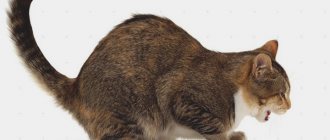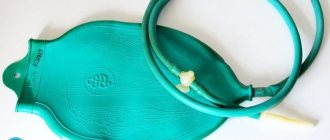In order to give an enema, and even to yourself, and even at home
conditions, you will need special equipment. Usually this thing is called an Esmarch mug, it is the Esmarch mug that is a kind of classic, a generally accepted device that allows you to correctly give yourself (or not only yourself) an enema - but not all people have an Esmarch mug. But such a simple thing with which you can do approximately the same thing and which is called a pear or a syringe - this is something that can be found in almost any home. And doing the procedure with its help is also more than realistic. Moreover, giving her an enema is no more difficult.
Indications - why is a cleansing enema done with a pear?
There are a large number of clinical cases when washing the digestive system is necessary, both from the point of view of organizing a therapeutic course for a patient who suffers from a particular disease of the internal organs located in the abdominal cavity, and for the general health of the body.
The main purpose of a colon cleansing enema is the following recommendations for use:
- preparation for a diagnostic examination of the gastrointestinal tract using an x-ray method (this preparatory procedure is also used in those clinical cases when there is a need to check the health of the tissues of the bladder, internal genital organs and urinary tract);
- chemical and digestive intoxication, imbalance of intestinal microflora when bacterial or enteroviral invasion has occurred;
- acute constipation, lasting for 3 days or longer (in fact, this is a fecal blockage, which can be eliminated with a pear enema at home to yourself without any help);
- endoscopic examination of the gastrointestinal tract using a digital probe inserted through the anus;
- preparation for surgical intervention on the abdominal organs.
A cleansing enema is mandatory for women who are in the last stages of pregnancy and, according to the calculations of the obstetrician-gynecologist, active labor should begin in the coming days, or a decision has been made to have a cesarean section.
The return of the rubber bulb
Once upon a time, an enema was used to treat almost everything from the flu to cancer. Then, when pills were invented for every disease, the rubber bulb disappeared into oblivion. Today it has again gained popularity, because it is an effective and simple way to cleanse the body of toxins accumulated in the intestines that poison a person without mercy.
A rubber syringe with a soft tip, 50 ml capacity, with which the intestines are washed, is very popular because it is easy to use. Its advantages:
- Designed for intestinal rinsing, holds 50 ml of solution, also suitable for rinsing ears.
- Made of non-toxic, soft and durable material.
- Sterilization is allowed.
The assortment includes various types and sizes of pears with a soft tip:
The intestines are a garbage dump. Its task is to receive and remove undigested and excess parts of food. Some of these poisons are deposited in the nooks and crannies of the intestines, rot and harden. Over time, there are more and more of them, and they harm the human body more and more. A “dirty” intestine works worse; poisons in the blood migrate throughout the body and weaken the body. Symptoms of poisoning are:
This is when you need to take a rubber bulb.
Advice for those who do not know how to do a pear enema at home: first you need to unload your stomach by drinking a glass of fresh sauerkraut juice, whey or buttermilk in the morning on an empty stomach.
People who are overweight or constipated can drink 30 g of Glauber's salt dissolved in ½ glass of water with lemon juice. This unpleasant, bitter-sour mixture can be diluted with mint decoction for a better taste. You should not leave the house for several hours, because bowel movements can occur very abruptly!
Contraindications and precautions
Despite the simplicity and harmlessness of this procedure, there are also restrictions on its use for people who have certain secondary diseases, or a tendency to develop pathological conditions of the digestive system. An enema to cleanse the intestines at home is strictly contraindicated in the following clinical cases:
- weakness of the walls of the capillaries of the epithelial tissues of the gastrointestinal tract, which is expressed in periodic bleeding from the anus (warm pear water can exacerbate this physiological phenomenon and cause large volumes of blood loss);
- hemorrhoidal disease in the acute stage, or inflammatory diseases of the colon;
- anal fissures, fistulas, rectal erosions;
- recently undergone surgery on the internal organs of the abdominal cavity, when the person is still at the stage of rehabilitation and healing of wound sutures.
In other cases, there are practically no medical restrictions on the use of a cleansing enema at home.
Despite this, gastroenterologists and proctologists strongly recommend that before starting this procedure, you go to the clinic at your place of residence in order to undergo a general consultation and receive methodological recommendations from specialists who will help formulate the optimal course of cleaning the gastrointestinal tract, tell you about the rules for its implementation, which can prevent injury to the rectum and the occurrence of undesirable consequences.
Basic preparations and water temperature
To carry out intestinal irrigation, as this procedure was called in the old days, we will need:
- Syringe bulb.
- Sufficient amount of boiled water.
- A container from which we will draw water into the pear.
A room temperature solution is perfect for our purposes. Cold water causes spasms and pain. Water that is too warm will be quickly absorbed and there will be no effect.
The safest enema for cleansing the intestines is simple warm water.
Dip the nozzle of the syringe into the water, squeeze it and draw the liquid into the bulb. Try to draw as much water into the syringe as possible, so less air will enter the intestines. Air in the rectum causes discomfort not only during the procedure, but also after it.
For painless insertion, the tip is lubricated with Vaseline or baby cream. Be careful if the intestines or anal ring have any damage; improper lubrication can cause pain.
How to give yourself a cleansing enema at home?
Most people who decide to improve the health of their gastrointestinal tract organs do not go to the inpatient department of general therapy so that the medical staff administers a cleansing solution into the anal cavity with its further distribution to all parts of the digestive system. It is quite possible to wash yourself without leaving home, but to do this you need to have the following useful information.
What to do with?
At one of the stages of preparation for the procedure, a completely objective question arises - what kind of water to use for cleaning. Should I use regular raw tap water or should it be boiled first? It is important to remember that the enema solution for cleansing the intestines is prepared only on the basis of boiled water. It can be saturated with additional additives that perform anti-inflammatory and antiseptic functions, having a beneficial effect on the irritated mucous membrane of the gastrointestinal tract.
The following recipes for preparing solutions are the most popular and have practical effect:
- boiled water, to which a small amount of table salt is added (the ratio of the components should correspond to the following proportions - 1 level teaspoon of salt is poured into 1 liter of water);
- chamomile decoction (it is prepared according to the principle that 15 grams of dried chamomile are added to 1 liter of water and it is boiled over low heat for the next 20 minutes, and after cooling, the liquid is filtered for small particles of the medicinal plant, cools down and is ready for refueling pear and practical application);
- enema with lemon to cleanse the intestines (an acidic environment, like a salty one, has antiseptic properties, so it is very effective when carrying out this procedure, and to implement it you need to take 1 liter of boiled water and add 2 teaspoons of pure lemon juice, which has been squeezed out immediately before the start of cleansing the gastrointestinal tract).
These are precisely the solutions that are considered the safest for the mucous membrane of the rectum, as well as other parts of the digestive system. Their preparation does not take much time and does not require a person to have special knowledge in the field of medicine or any other skills in this industry.
Execution algorithm
For those who don’t know, an enema looks like an ordinary bulb, but only rubber and it also has an elongated plastic end that resembles a pipette. To do the procedure for cleaning the gastrointestinal tract correctly, you must adhere to the following rules:
- Fill the rubber bulb with the required amount of liquid (it is advisable that it be filled completely, as this will prevent air from entering the anal cavity).
- Lubricate the plastic end of the enema with a lubricant (it is best to use regular baby cream or Vaseline).
- Get on all fours. Elbows and knees should be firmly fixed to the surface of the couch or bed on which the procedure is performed, and the head should be tilted forward so that the buttocks rise above the general level of the back and body as a whole.
- Spread your legs and insert the base of the bulb into the rectal cavity. Release the cleaning solution gradually to avoid internal discomfort. When the enema is empty, it is smoothly removed, and the person continues to be in this position for the next 3-5 minutes so that the necessary effect of flushing the digestive system is achieved.
How to give an enema? Preparatory stage
Not everyone knows how to do an enema with a pear correctly.
That is why it is so important to learn as much as possible about it before undergoing the procedure, and also consult with your doctor. So, in order to give an enema, you need to prepare the following equipment:
- enema tool (in our case, a rubber bulb);
- water in the required volume or as a solution with glycerin or other substance;
- petroleum jelly, baby cream or petroleum jelly;
- oilcloth.
Before the procedure, the pear itself should be thoroughly washed with soapy water, and the same should be done with the tip.
If you use plain water, then follow the temperature rules: no more than 35 degrees.
If you add glycerin or any other substance, then do no harm either. Glycerin or vegetable oil is taken from the proportion of a tablespoon per half liter of water .
Contraindications
- gastrointestinal bleeding;
- intestinal obstruction;
- acute inflammatory processes of the colon, anus;
- the first days after surgery on the gastrointestinal tract;
- rectal prolapse;
- bleeding hemorrhoids;
- acute appendicitis;
- peritonitis;
- malignant neoplasms of the rectum;
- pathologies of the cardiovascular system.
The feasibility of the procedure is determined by the doctor.
Staging
When the syringe/bulb is ready, you need to understand how to do the procedure. First you need to prepare the space where the procedure will be carried out. The surface must be horizontal and certainly covered with oilcloth or something similar. Next, the solution is poured into the pear. This is done by pressing the bulb - the air comes out, after which you can draw a liquid.
Then you need to press the device a little so that the air comes out of it. If you are doing a pear enema to yourself at home, now you need to find the position that will be most convenient and comfortable for you. This can be a fetal position, it can be squatting or all fours - entirely your choice.
The tip of the device is lubricated with Vaseline so as not to cause unnecessary injuries when inserted. Then the buttocks are slightly moved apart, and the tip of the bulb syringe is inserted approximately three centimeters. The liquid is introduced slowly, completely. You need to keep it inside for about 10 minutes, and then you can go to the toilet.
Preparation for the event
Inventory
Before the procedure, prepare materials and instruments. Would need:
- oilcloth (approximately 150*100 cm);
- basin;
- napkin;
- balloon bulb (syringe);
- hydrogen peroxide 3% (if using a bulb with a hard tip);
- petrolatum;
- enema solution (prescribed by a doctor);
- sterile gloves.
For a cleansing enema, it is better to take a balloon bulb with a long tip (10–15 cm). Since it is recommended to administer 1–1.5 liters of liquid for a complete bowel movement, it is better to take a syringe with a volume of 470 ml (for a salt, oil, emulsion enema, 100–200 ml is enough).
Boil the pear for 10–15 minutes before use. If the tip is hard, remove it and soak it in a 3% hydrogen peroxide solution for 15 minutes. Then it is connected to the bulb.
Preparing your workspace
It is better to do the enema while lying on your side, and then remain in a lying position for at least 10 minutes. Therefore, you should prepare the place where the procedure will be performed.
An oilcloth is placed on the bed so that one end hangs from the bed (a basin is placed under it). The oilcloth is covered with a diaper.
Prepare an enema solution. Place it near the bed so that it is convenient to draw liquid into the syringe without changing position.
Venue and position
A bed is suitable for performing an enema at home. Choose it so that you can quickly run to the toilet if necessary, and you won’t feel uncomfortable with embarrassment.
The fetal position for self-administration of the drug is ideal. Take a comfortable position on your left side, carefully insert the syringe into the anus and press the bulb. Make sure that the tip does not rest against the wall of the anal ring, otherwise the water will not flow into the intestine or will even begin to pour out.
Wait 5-10 minutes after introducing the liquid; softening of the stool does not occur instantly. To penetrate the solution as far as possible, you can carefully stand up and walk around. If your stomach is churning, massage it lightly to relieve discomfort.
After the designated time, you can go to the toilet and cleanse the body of harmful substances.
By following the simple rules described above, you can easily give yourself an enema without involving strangers. And after the enema you will feel lightness, reduce pain and achieve the goals for which all this was started.
Enema solutions
Various solutions are used for cleansing enemas. The temperature of the liquid should be 22–23 ° C, or 36–38 ° C. The cold solution enhances intestinal motility and is prescribed for atonic constipation. Warm – relaxes, relieves spasms. If it is necessary to cause severe intestinal irritation, it is recommended to use liquid cooled to 12–20 ° C.
- saline;
- soda;
- herbal;
- oil;
- emulsion;
- potassium permanganate.
Even boiled water is used for enemas.
Which solution to choose depends on the disease and the purpose of the prescribed procedure.
Saline
Hypertensive enemas effectively cleanse the intestines. They help remove a larger volume of fluid, soften stool, stimulate the release of loose stools, and enhance intestinal motility. Apply:
- 10% sodium chloride solution (10 g of table salt per 100 g of water);
- 20–30% solution of magnesium sulfate;
- 20–30% sodium sulfate solution.
The procedure requires 100 ml of solution. It is heated to 37–38 °C. After administering the liquid, it is not recommended to stand up for 20–30 minutes.
It is contraindicated for ulcers, anal fissure, acute inflammation of the lower part of the large intestine, and edema.
Soda
Soda solution is prescribed for increased acidity of stool. It helps relieve pain caused by irritation of the intestinal mucosa with liquid feces during diarrhea. It is believed to be effective in the treatment of helminth infections. Recommended for cleansing the intestines with acetonemia.
To prepare the solution you need:
Sodium bicarbonate is dissolved in warm water. To cleanse the intestines, 1–1.5 liters of liquid are administered. The solution temperature should be 37–38 °C.
Herbal
Herbal infusions are recommended for cleansing enemas. Prescribed:
- Melissa infusion. Crushed shoots (3 g) are poured with a glass of boiling water and left for 20–30 minutes. Strain thoroughly. A warm solution (37–38 °C) should be administered. This enema relieves spasms.
- A decoction of flaxseed (oats, barley) and mallow leaves. The collection (1 tbsp) is poured into 1 liter of water. Boil for 10 minutes, filter, add 1 tbsp. l. salt, 2 tbsp. l. oil (linseed, hemp). I use this enema as a laxative for chronic constipation.
- Chamomile decoction. Chamomile flowers (6 tablespoons) are poured into 0.5 liters of boiling water. Place in a water bath and boil for 15 minutes. Allow the broth to cool, filter, and squeeze out the remaining raw materials. Add boiled water to the resulting broth to a volume of 0.5 liters. Add 2 tbsp. l. honey. This solution not only cleanses the intestines, it is anti-inflammatory and antibacterial.
Decoctions should be prepared in enamel containers. It is better to buy plant raw materials at a pharmacy or collect them yourself (away from railways, roads, and factories). It is strictly not recommended to buy herbs by hand, as they could have grown in contaminated areas and harmful substances have accumulated in them.
Herbal enema solutions should be used only as prescribed by a doctor and with extreme caution - they cause allergies.
Oil
Used to empty the lower part of the colon from feces and gases during spastic constipation, in the postoperative period, after childbirth. This is a long-acting enema. After it you should lie down for at least 8 hours. Therefore, it is better to put it before bed (the act of defecation should occur in 10–12 hours).
Laxative enema for constipation
Which enema solution to use for constipation depends on the condition of the intestines.
So, laxative enemas for constipation:
- Cleansing enema. Boiled water at a temperature of 36-40 degrees is used.
- Oil enema. Vegetable oil (50-100 ml) is heated to a temperature of 38°C, you can use petroleum jelly. If an enema with castor oil is prescribed, then 2-3 tbsp. spoons are stirred in 100 ml of water.
- Hypertensive enema. 30 grams of magnesia powder (30% solution) are dissolved in 100 ml of water.
- Saline enema. 1 tbsp. salts are stirred in 100 ml of boiled water. The solution is administered using a syringe. It happens that half the prepared volume is enough.
How to carry out the procedure
An enema should be given only as prescribed by a doctor. The specialist will recommend which solution will be most effective, to what temperature it should be heated or cooled, and how much to administer.
Stages of the procedure:
- Wear sterile gloves.
- Lubricate the tip of the syringe and the anus with Vaseline.
- Lie on your left side, tuck your legs and bring them to your stomach. At the same time, manage to spread the buttocks with one hand, while holding a napkin near the anus, and insert the syringe with the other.
- The tip should enter the anus to a depth of 10–12 cm. Insert it carefully, using rotational movements.
- Slowly press on the balloon bulb and pour in its contents. You should not sharply squeeze the syringe, as strong pressure of liquid can damage the intestine. If you feel strong pressure or acute pain, stop the procedure immediately and seek medical help.
- The pear should be removed from the rectum carefully.
- Use a napkin to wipe the skin from the perineum to the anus.
- Close the buttocks tightly, carefully pull out the oilcloth with the diaper.
After administration, you should lie down on your left side for 10 minutes. Then roll over onto your right side. You should breathe with your stomach. This will help move water into the intestines. After an enema, you need to lie down for at least 20–30 minutes (except for an oil enema).
In case of anal fissure, the procedure must be carried out extremely carefully. An enema is given as many times a day as the urge to defecate occurs. The tip is inserted into the anus along the edge of the anus on the side opposite to the fissure.
Immediately after bowel movements, a bath with potassium permanganate is necessary. Then a suppository lubricated with novocaine, streptocide and zinc ointment is introduced.
To cleanse the intestines of toxins, the following scheme is recommended:
- Day 1 – before bedtime, 0.5 liters of liquid are administered;
- Day 2 – 1 liter of solution is administered;
- 4th day – 1.5 liters required;
- Day 7 – give a 2 liter enema.
On days 3.5 and 6 they take breaks. They are needed to prevent intestinal motility from being disrupted.
To administer large volumes of liquid, it is better to use an Esmarch mug, since the maximum volume of a syringe is about 0.5 liters. And administering an enema several times in a row will further irritate the intestines.
Execution technology
How to give a pear enema to an adult? This process consists of certain stages:
- Wear disposable gloves.
- The tip of the bulb, as well as the anus, is lubricated with Vaseline.
- The patient lies on his left side, tucks his legs and pulls them towards his stomach. If you are interested in how to give yourself a pear enema, then you will have to try to spread the buttocks with one hand, at the same time hold a napkin near the anus, and insert the pear with the other hand.
- The tip must be inserted into the posterior hole to a depth of 10-12 cm. This must be done carefully, using rotational movements.
- Slow pressure is applied to the syringe and the solution present in it is poured. It is forbidden to press sharply on the device, since excessive pressure of liquid can lead to damage to the intestine. If a person feels strong pressure or acute pain is present, the procedure must be stopped immediately and an ambulance is called.
- Removing the pear from the rectum must be extremely careful.
- Using a napkin, wipe the skin from the perineum to the anus.
- The buttocks are tightly closed and the oilcloth and diaper are carefully pulled out.
After inserting the bulb, you need to lie on your left side for 10 minutes, after which the patient turns over to your right side. Breathing should be done with the stomach, this will ensure the movement of water through the intestines.
Possible complications and consequences
The procedure is carried out very carefully, as prescribed by the doctor, otherwise, instead of recovery, you can do a lot of harm.
- You should not give an enema often. The intestines will be “offended” and will not want to cleanse themselves. Enemas and laxatives contribute to the development of “lazy bowel” - a pathology that occurs due to weakened intestinal motility.
- The procedure helps cleanse the intestines not only of feces and gases, but also of beneficial microflora. And it is necessary for complete digestion and absorption of food. It has been proven that beneficial microflora helps strengthen the immune system. And without it, pathogenic microorganisms will begin to multiply in the intestines.
- If you insert the syringe incorrectly, you can damage the intestine. At best, a small wound will appear on the mucous membrane, at worst, a rupture will occur, and the entire contents of the intestine will fall into the abdominal cavity. Peritonitis will develop. Urgent surgery will be required.
- If there is no bowel movement after a certain time, intoxication may occur. Since harmful substances will dissolve and begin to be absorbed.
- When a large amount of fluid is administered, especially with pathologies of smooth muscle tissue, stretching of the intestinal walls will occur. The pressure inside the lumen will increase. This will lead to additional irritation and exacerbation of the pathological process.
Therefore, before carrying out the procedure, compare the benefits and harms of an enema.
Cautions
A homemade enema is not the best option for colon cleansing. During use, mechanical damage to the tissues of the anus and rectum, thermal burns, and excessive stretching of the intestinal walls, even to the point of rupture, cannot be ruled out. Some of the complications pose a direct threat to human life, therefore, unless absolutely necessary, it is not recommended to use an enema from improvised means.
In order to avoid the need for an enema to facilitate bowel movements and cleanse the intestines during constipation, it is recommended to carry out preventive measures. They allow you to normalize stool and include a rational diet and physical activity.
Advantages and disadvantages
Sometimes it is necessary to cleanse the intestines. When using a syringe for this, it is important to consider that it has its advantages and disadvantages.
| № | Advantages | Flaws |
| 1 | In the first stages of treatment, an enema is an effective means of cleansing the intestines. | Long-term use leads to impaired peristalsis, up to the complete loss of independent urge to defecate. |
| 2 | A syringe is convenient if you need to administer an enema yourself. | The maximum volume of the balloon bulb is 0.5 liters. And sometimes it is necessary to administer more than 1.5 liters of liquid. |
| 3 | When using a balloon bulb, liquid is injected into the intestines using a pressure method. Strong pressure helps flush out feces. | In certain pathologies, this method of administration will lead to complications (stretching of the intestinal walls, rupture of adhesions). |
| 4 | Promotes bowel movement from feces and gases. | Washes away beneficial microflora. |
| 5 | For the treatment of atonic constipation, an enema is good because it causes additional irritation and increases peristalsis. | Irritation of the mucous membrane increases inflammation, causes intestinal spasm and, accordingly, increases pain. |
Before using an enema, you must remember the contraindications. Sometimes it is better to replace it with other means.
Procedure frequency diagram
If there is a fissure in the anus, the procedure must be performed very carefully. This should be done as many times a day as there is a urge to defecate.
To completely cleanse the body of waste and toxins, the following enema scheme at home is recommended:
- 1st day – 500 ml of liquid before bedtime;
- 2nd day – liter of solution;
- 4th – 1.5 liters of liquid;
- 7th – a 2-liter enema is administered.
Days 3, 5 and 6 are breaks. They are necessary to prevent disturbances in intestinal motility.
Alternative methods of colon cleansing
For constipation, an enema is a last resort method of bowel movement. I recommend it when straining the muscles of the abdominal wall and perineum is contraindicated, you cannot strain so that the stitches do not come apart (after surgery on the abdominal organs) or a relapse occurs in a chronic anal fissure. If possible, they try to replace the cleansing enema with:
- Laxatives. Before conducting an instrumental examination of the colon, Fortrans is prescribed, an osmotic laxative. The urge to defecate occurs 1 hour after taking the drug. The medicine has contraindications. Before use, consult a doctor.
- Glycerin suppositories. They are most effective for atonic constipation, but are addictive.
- Therapeutic exercise. There are exercises that help restore normal intestinal motility.
- Massage. It is prescribed and carried out by a specialist.
- Nutrition correction. A common cause of stool retention is poor nutrition. In order for the intestines to function properly and cleanse themselves, increase the consumption of foods containing fiber.
If you have stool retention or diarrhea, you should not do a cleansing enema without permission. The cause of any digestive disorders is immediately determined. To do this, contact a gastroenterologist or proctologist.
You can do a pear enema yourself at home, without outside help. The method is easy to use, subject to simple rules and recommendations. Effectively solves problems with the passage of feces and helps cleanse the intestines.
Description of compositions
The home method of cleansing using solutions should be selected in accordance with the doctor’s recommendations. Cleansing is carried out according to this recipe.
Salt and soda
The solution is made in the following proportion: 10 g table salt / 100 g water (10%). Use 20-30% solutions based on Mg and Na sulfate.
The water is heated to a maximum of 38 0C. After the procedure, it is recommended to lie down for half an hour. Contraindications: peptic ulcers, cracks, acute inflammatory reactions and swelling.
Soda solution is prescribed to relieve pain when stool has a high level of acid content. The proportion of the solution is 1.5 l. water / 50-60 g of soda at a temperature of 37-38 0C.
Herbal
Traditional medicine gives three ways to prepare herbal infusions. It is recommended to cook in enamel pans, prepare the collection yourself (away from the highways, railways) or buy it at a pharmacy. Be careful when using herbs - allergic reactions are possible!
Melissa infusion against spasms: 3 g of plant per glass of boiled water. Let it brew for half an hour. Temperature 37-38 0C.
Decoction of flaxseed (oats, barley) and mallow leaves: 1 tbsp. l. / 1 l. water, bring to a boil (10 minutes) and strain. Add ingredients: 1 tbsp. l. salt, 2 tbsp. l. oils Used for frequent constipation.
Chamomile decoction: 6 tbsp. l. / 0.5 l. boiling water, place in a water bath for 15 minutes. Strain and squeeze out the resulting raw materials. Add an additional 0.5 liters. and 2 tbsp. l. honey. An excellent remedy for combating inflammatory processes and harmful bacteria.
Oil
Used to achieve emptying of feces and gases in the large intestine. The enema used lasts for a long time. After the procedure, it is better to lie down for up to 8 hours. Therefore, cleanse before bed.
Oil affects the intestines mechanically (softening of stool) and chemically (breakdown of matter, appearance of soap). The substance is heated to the maximum limit in an amount of 100-200 ml.
An oil enema is recommended as a softening agent. There are general contraindications.
Emulsion
Composition of the solution: 0.5 ml of chamomile infusion, 1 yolk, 1 tsp. soda powder and 2 tbsp. l. Vaseline (glycerin). Emptying will occur in 30 minutes.
Potassium permanganate solution
Proportion: 1.5 l. water (36-38 0C) / 4-5 crystals of permanganate K. It is dangerous to use a highly concentrated solution. A remedy is prescribed to eliminate diarrhea and hemorrhoids (pay attention to the presence of bleeding). Potassium permanganate can dry out the intestinal mucosa and cause irritation.
Esmarch's mug can handle large volumes of solutions so as not to cause irritation of the gastrointestinal tract by frequent use of an enema.
Pros and cons of using an enema bulb
An enema is used for therapeutic or cleansing purposes and helps solve problems in the gastrointestinal tract.
The procedure is performed by infusing liquid using a pear or Esmarch mug.
It is often used in the maternity ward before childbirth, in the infectious ward - if the patient suffers from poisoning or intoxication. The usefulness of an enema is to relieve spasms and activate intestinal motility. The process has advantages and disadvantages, including:
| Advantages | Flaws |
| An enema helps to effectively cleanse the intestines. | Frequent use causes disturbances in peristalsis and loss of independent desire to empty the intestines. |
| The pear is convenient to use when performing the procedure yourself. | Insufficient volume for the procedure. In some situations, an injection of 1.5 liters is required, with a maximum volume of a pear of half a liter. |
| The pressure method of administration helps flush out feces and cleanse the intestines. | There are contraindications; an enema can cause stretching of the intestinal walls and rupture of adhesions. |
| An effective remedy for the treatment of atonic constipation, it promotes increased peristalsis, causing defecation. | Irritates the mucous membrane, promotes the development of inflammation, and washes away beneficial microflora. |
It is advisable to undergo examination and consult a doctor before use.
The most popular questions in the topic “Enemas, their forms and indications”
Often, patients refuse artificial cleansing for reasons of embarrassment, misconceptions and knowledge about this method of treatment.
Unfortunately, at the moment, in some cases, a better option for enemas to alleviate the patient’s condition has not yet been invented, so we are answering the most common questions in order to dispel myths.
What is the name of the enema bulb and where to buy it
A bulb for douching is sold at any pharmacy. It is also suitable for aspirating fluid from the nose and for performing an enema.
In order not to make a mistake with the volume of liquid, you need to buy a bulb of a certain volume. Repeated use of the pear is allowed if it is thoroughly disinfected.
What forms of enema are best used for constipation and hemorrhoids?
For constipation, it is best to use medicinal microenemas that are not addictive. Remember that constipation is a symptom of a disease, and in order to get rid of it, you need to treat the immediate cause, which is poor diet, dehydration and a passive lifestyle.
For hemorrhoids, enema is contraindicated in the presence of even slight bleeding, so performing the procedure independently when the veins of the rectum are dilated is not advisable.
What is the name of a cleansing enema that is used to detoxify the body?
When the body is intoxicated, soda solutions or compositions with sorbents or polysorb are often used to remove toxins from the intestinal cavity.
Can pills or droppers replace an enema?
No! An enema is a quick mechanical removal of toxins from the intestines. The action of tablets is often ineffective in emergency cases, and droppers are aimed at eliminating toxins only in the bloodstream.
Considering that the positive effects of an enema are greater than the side effects from it, it is safe to say that this type of treatment will be popular among certain medical specialties for a long time.
Enemas are often used in intensive care units, infectious diseases departments, and as preoperative preparation for patients in surgery.
Instructions for doing it at home
An enema is used as a means of combating constipation; you can cleanse the intestines of waste and toxins, promoting weight loss. You can buy a pear at a pharmacy. Product volume:
- 50 g – for children’s enema;
- 300 g – volume for a standard enema;
- 500 g is the volume for a full enema of an adult body.
There are different tips made from plastic, silicone and rubber. In pharmacies, for convenient use, microenemas with a ready-made laxative are sold. A standard volume of syringe will help relieve constipation in an adult. To cleanse the intestines, it is recommended to use an Esmarch mug.
They give an enema to an adult at home with a pear, following step-by-step instructions, which include several stages.
Preparation
Not everyone knows how to do douching without consequences. It is recommended to consult a doctor who will explain the process in detail and suggest useful solution recipes, depending on the problem.
To carry out the manipulation you will need:
- rubber bulb;
- liquid for infusion - warm boiled water with the addition of other substances or a solution prepared independently;
- Vaseline or baby cream to lubricate the tip;
- disposable diaper, you can use oilcloth.
Before starting, be sure to wash the bulb and tip with soapy water. Prepare the injected solution in advance. When introducing water, monitor the temperature; a suitable temperature is 35 degrees. When infusing the medicinal solution, observe the proportions.
Choose a convenient place for the manipulation, preferably in a horizontal position. Cover the surface with oilcloth.
Selection of solution and its temperature
For enema treatment, there are various types of solutions that have special properties to eliminate diseases. A simple option - boiled water, does not have a therapeutic effect, but effectively removes fecal impaction. To enhance the effect, you can dilute manganese in water.
An enema for cleansing the intestines with a pear is used in some recipes that enhance the cleansing effect:
- 50 ml vegetable oil per 100 ml water. Heat the oil to 38 degrees and mix with water (you can replace it with Vaseline oil);
- 3 tbsp. castor oil per 100 ml of water.
- 30 g of magnesia per 100 ml of water;
- 1 tbsp. salt per 100 ml of water.
In order to lose weight and give a slim figure, use the following recipes that have the desired effect:
- Lemon juice. The solution is prepared from freshly squeezed juice, in a volume of 50 ml of juice per 1 liter of water. The recipe normalizes the intestinal microflora and removes harmful accumulations.
- Apple vinegar. The solution is prepared from 1 tbsp. vinegar per 2 liters of water. An enema is allowed once every seven days, for three months. Excessive use will affect the intestinal microflora.
- Baking soda. To prepare the solution, mix 1 tsp. soda per 1 liter of water. Cleanses the body of harmful accumulations, accelerating the weight loss process. Give an enema once every seven days.
Once you have prepared the liquid, suck the contents into the bulb. Dip the tip into the water, release the air and gradually release the rubber ball, absorbing the liquid. Try to draw the maximum amount of solution so as not to introduce air into the intestines. To eliminate air, squeeze the sides, squeeze out the air until water appears. Lubricate the tip with a small amount of greasy product for painless insertion into the anus.
Carrying out the procedure
Having prepared everything you need, take a position lying on your right side (in the fetal position). Begin to insert the tip 3 cm, slowly plunging into the outlet of the hindgut, spreading the buttocks with your fingers.
Slowly squeeze the syringe, ensuring a gradual infusion of the solution into the intestine. Upon completion of the injection of the solution, carefully remove the tip, slowly, so as not to injure yourself.
For deep penetration of the liquid, you can walk around the room. If there is no positive result, the procedure is repeated 6 hours later. When finished, rinse the bulb and tip.
Cure for overeating
Asclepiades, one of the Greek fathers of medicine, was an ardent supporter of this procedure. He argued that an enema not only cures diseases of the body, but also enlightens the mind. The Romans, after a fatal gluttony, did not part with a device for cleaning the intestines. They were helped by a structure resembling a funnel connected to a leather bag.
Medieval pharmacists and barbers used a proven method of treating those with increased body weight and a sick soul who sought help - they did an enema. By the way, back in the last century it was called an enema.
The German scientist Esmarch invented a special mug, which now bears his name. Warm water with the addition of table salt, vinegar, soap or oil, or glycerin was poured into the intestines using a rubber tube. The device solved the problem of how to make an enema without a pear. It was obligatory to lie for 10 to 30 minutes on the left side to soften what had to come out of the body.
Which is better: Esmarch's mug or pear?
The pear is convenient to use when administering a small amount of liquid up to half a liter, which is important for a child. To carry out a full procedure for an adult, if more liquid is required, it is better to use an Esmarch mug. For independent use, take a bulb; it is easy to use and one slow press is enough to introduce all the liquid.
To manipulate the mug, you will need outside help; you will need to hold it at a height of up to 1.5-2 m. You will need to regulate and deflate the air using a faucet, which is impossible when used independently.
To carry out cleaning at home yourself, a rubber bulb will do the job better. You should not overuse an enema; it can cause a decrease in peristalsis and leaching of beneficial microflora, which leads to chronic constipation. Reasonable use will improve the body without harm to health.
Selection and Application
Sometimes a bulb/syringe is used simply because Esmarch’s mug is missing, but sometimes it is actually more convenient. This is, for example, when it is necessary to do a small enema, no more than half a liter. You can generally find 50 gram pears that are suitable even for very young children. But for large volumes, when a cleansing enema is needed, Esmarch’s mug will be much more optimal.
There are disposable syringes that make it even easier to do an enema at home, since they already contain everything you need. All that remains is to do the enema, and then throw away the now unnecessary syringe, so it’s easy to use. In general, you can never guess when you will need to do an enema, so you should at least have a standard pear at home. You can choose an option with a plastic, silicone or rubber tip, everything to your taste. But if you need to do the cleansing procedure quite often, then perhaps the Esmarch mug will still be more convenient, because at least its volume is larger and this cleansing procedure is carried out easier and more correctly with its help. Therefore, sometimes it is better to use it.
Alternatives to the technique
There are alternative methods of colon cleansing without the use of an enema. Basically, these are medications of various pharmacological groups that allow you to cleanse the intestines, enhance peristalsis and get rid of sludge from the body.
Their main disadvantage is the duration of action. They can be used as preparation for research or planned surgery, for the treatment of chronic constipation, but not as an emergency treatment for acute obstruction or emergency preparation of a patient for surgery.
prokishechnik.info
Interesting facts about clyster
Klystyres in the Middle Ages
Klystyres (the name comes from the Greek word “klyste”, which means “to wash”) was created during the life of Hippocrates. The first device was very different from those we see now. The enema was a bubble made from the intestines of a large animal. An elderberry tube was attached to the bladder, which was inserted into the anus. The doctor inserted the end of the tube into the anus, pressed on the bladder and the liquid entered the intestines.
Since then, the clyster has changed. In some areas it was even made of metal, and a piston was used to pour water into the intestine. Scientists have found evidence where the horn of cattle served as an enema: the thin end was inserted into the anus, water or herbal infusion was poured into the horn, and the doctor blew into the wide end so that all the liquid entered inside.











